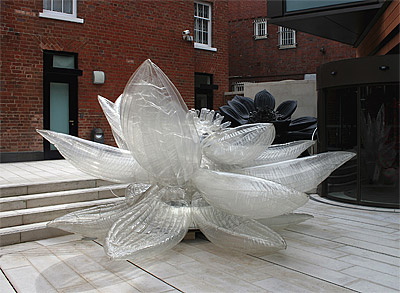Choi Jeong Hwa
Korea
1961
Clear lotus
2009
urethane vinyl, motor
230 (h)
cm
400 cm (diameter)
The Gene and Brian Sherman Contemporary Asian Art Fund, 2009
National Gallery of Australia, Canberra
NGA 2009.51
Choi Jeong Hwa is renowned for his inflatable sculptures and constructions using mass-produced plastic products, and re-presented found or borrowed objects. While much of his work can be interpreted as communicating concerns about waste, consumer society, globalisation and other contemporary issues, the artist consciously avoids such discussion. Rather, he celebrates the peculiar beauty of synthetic materials and everyday objects with flippant lightness and deliberate ambiguity of purpose.
An enormous transparent vinyl bloom, Clear lotus magnificently inflates and opens, before deflating to sprawl dejectedly on the ground. Then the cycle begins again. The stylised sculpture has elegantly fluted petals with a central clumping of tentacle-like anthers. In Buddhist art the auspicious lotus rises from swampy waters to bloom pure and exquisite, despite its often filthy origins. Although not a practising Buddhist, Choi grew up in a devout family and has a strong understanding of religious philosophy and symbolism.[1] When discussing a much earlier inflatable flower sculpture, the multicoloured and variegated Super flower 1995, he referred to the capacity of the lotus to remain untainted by its genesis as a source of inspiration.[2] Still, the lotus blooms only briefly before the petals blacken around the edges and fall off, leaving a dry pod and woody stem. Choi’s flowers, however, and Clear lotus in particular, continually bounce back, as pristine, plump and sparkling as the first time their petals opened.
An active contributor to the development of the Korean contemporary art scene in the early 1990s, Choi is also a designer of interiors, furniture and architecture. He began his career as a painter but soon abandoned it for installation, video and sculpture. Among his best-known works is The death of the robot—about being irritated 1995. The orange blow-up robot struggles to get up from the ground but, worn down by the effort, is repeatedly thwarted. According to the artist ‘the work had its start in a personal feeling of powerlessness. What’s most important is the contradiction between this apparent human vulnerability or failing in something that embodies supreme technological advancement.’[3]
Many of Choi’s recent gigantic inflatables are floral in form and, like Clear lotus, created in monochrome: either in bright single colours or in black, white or transparent plastics. His lotuses in particular have attracted considerable attention following the appearance of Dragon flower, a white bloom displayed in a garden setting outside the Korean pavilion at the Venice Biennale in 2005. Although the artist is not easily drawn on the meaning behind his sculptures, about his floral works he has said: ‘I feel strange when I see a real tree or flower. Nature, as such, is so rare in Korea these days, that I’m actually afraid when I encounter it. I’m afraid of the “real”. Maybe all I can deal with is an idea of nature, immune to destruction, so I make an artificial one to look at and enjoy.’[4]
Melanie Eastburn
Curator, Asian Art
National Gallery of Australia, Canberra
[1]Jiyoon Lee, ‘Choi Jeong Hwa: enfant terrible or artist-philosopher?’, in Choi Jeong Hwa, Wolverhampton Art Gallery, Wolverhampton, 2007, unpaginated
[2]Choi Jeong Hwa, artists’ talk, Second Asia–Pacific Triennial of Contemporary Art, Queensland Art Gallery, Brisbane, September 1996
[3]Choi Jeong Hwa, interview with James B Lee, ‘Flim-flam and fabrication: an interview with Choi Jeong-Hwa’, Art Asia Pacific, vol 3, no 4, 1996, p 66
[4]Choi, Art Asia Pacific, p 66

